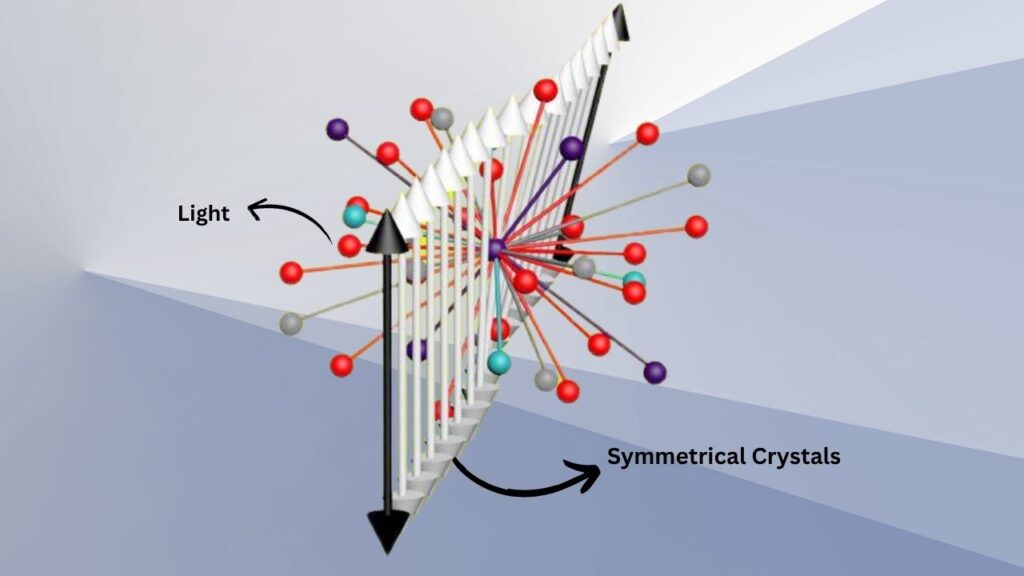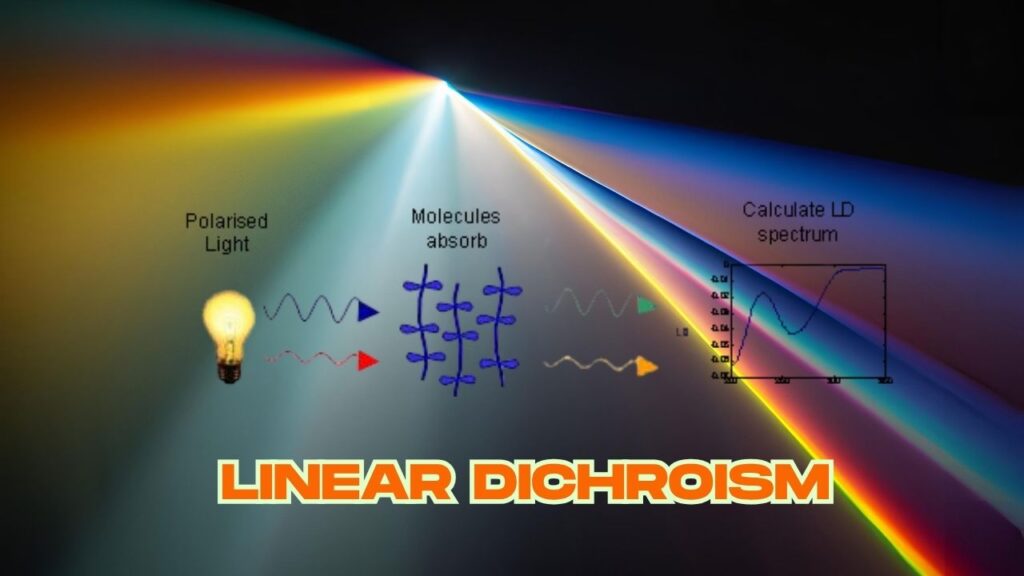Scientists Discover Why Symmetrical Crystals Absorb Light Unevenly: For generations, scientists believed that the rules of symmetry in crystals were absolute. If a crystal was perfectly symmetrical—meaning its structure looked the same from every angle—then it should interact with light in a perfectly balanced way.

But in a groundbreaking 2025 discovery, researchers at Northwestern University and the University of Wisconsin-Madison have shown that symmetrical crystals can absorb light unevenly, overturning decades of scientific assumptions and opening new doors for technology and materials science.
Scientists Discover Why Symmetrical Crystals Absorb Light Unevenly
| Key Point | Details |
|---|---|
| Discovery | Symmetrical (centrosymmetric) crystals can absorb circularly polarized light unevenly, showing chiral-like behavior. |
| Material Studied | Centrosymmetric lithium cobalt selenite oxide (Li₂Co₃(SeO₃)₄) crystal. |
| Mechanism | The effect is due to interference between linear dichroism and linear birefringence (LD-LB), not a violation of symmetry rules. |
| Implications | Could lead to brighter displays, advanced sensors, and secure optical communications. |
| Published In | Science, June 2025 |
| Research Institutions | Northwestern University, University of Wisconsin-Madison. |
| Official Source | Northwestern University News |
The discovery that symmetrical crystals can absorb light unevenly is a landmark in materials science, challenging old dogmas and offering new possibilities for technology. By revealing that even the most symmetrical materials can behave in surprisingly complex ways, this research paves the way for innovations in displays, sensors, and secure communications. As scientists continue to explore the hidden properties of crystals, we can expect even more exciting breakthroughs in the years ahead.
What Are Symmetrical Crystals?
Symmetrical crystals, technically called centrosymmetric crystals, are materials whose atomic arrangement is identical in every direction from a central point. Think of a snowflake or a soccer ball—no matter how you turn it, the pattern remains the same. This symmetry is not just aesthetically pleasing; it strongly influences how the material behaves, especially in response to light and other electromagnetic waves.
Why Symmetry Matters
In science, symmetry often means predictability. For crystals, symmetry has been a guiding principle for predicting how they interact with light, electricity, and magnetism. Traditionally, only asymmetrical (non-centrosymmetric) crystals were believed to exhibit chiral behavior—meaning they could interact differently with left- and right-handed forms of circularly polarized light.
The Old Rule: Only Asymmetrical Crystals Show Chirality
Chirality is a property where an object or system behaves differently from its mirror image, like your left and right hands. In optics, this means a material can absorb or transmit “right-handed” and “left-handed” circularly polarized light differently.
Circularly polarized light is a special kind of light wave that twists as it moves, either clockwise or counterclockwise. In the past, scientists believed that only crystals lacking a center of symmetry could distinguish between these two types of light. This belief was so well accepted that it formed the basis for designing optical materials and devices for decades.
The Breakthrough: Symmetrical Crystals Absorbing Light Asymmetrically

In a landmark study published in Science in June 2025, researchers led by Dr. Roel Tempelaar and Dr. Paul S. Weiss demonstrated that a fully symmetrical crystal—specifically, lithium cobalt selenite oxide (Li₂Co₃(SeO₃)₄)—can, in fact, absorb circularly polarized light unevenly.
How Did They Discover This?
- Theoretical Predictions: Advanced quantum mechanical models suggested that under certain conditions, even symmetrical crystals could interact with circularly polarized light in a chiral manner.
- Crystal Synthesis: The team synthesized high-purity, centrosymmetric crystals in the laboratory.
- Optical Experiments: By shining both right- and left-handed circularly polarized light through the crystals and measuring the absorption, they observed a clear difference—one direction of light was absorbed more than the other.
- Reproducibility: The effect was consistent and could be reversed by flipping the crystal, confirming that the phenomenon was real and not an experimental artifact.
“Crystals are really categorial because of their symmetry. You can infer a lot about their behaviors—without doing complicated calculations or measurements—just by looking at their symmetry. Now, we realize that sometimes there is more than meets the eye,” said Dr. Roel Tempelaar.
The Science: Why Does This Happen?
The key to this discovery is a subtle effect called interference between linear dichroism and linear birefringence (LD-LB).
Breaking Down the Terms
- Linear Dichroism (LD): The crystal absorbs light differently depending on the direction of the light’s electric field.

- Linear Birefringence (LB): The crystal bends or refracts light differently depending on the direction of the light’s electric field.

- Interference: When these two effects are present together, they can combine in such a way that the crystal absorbs one type of circularly polarized light more than the other—even though the crystal itself is symmetrical.
This does not violate any fundamental laws of symmetry. Instead, it reveals a hidden layer of complexity in how light interacts with matter. The effect is so robust that flipping the crystal reverses which direction of light is absorbed more, providing a powerful new tool for controlling light in materials.
Real-World Implications and Applications
This discovery is not just a theoretical curiosity—it has the potential to transform several fields:
Brighter, More Efficient Displays
By harnessing this effect, engineers could design display materials (for TVs, smartphones, and monitors) that control light more efficiently, resulting in brighter screens with lower energy consumption.
Advanced Optical Sensors
Sensors that detect tiny differences in light polarization could become much more sensitive, improving medical imaging, environmental monitoring, and scientific research tools.
Secure and Fast Optical Communications
Optical fibers and quantum communication systems could use this property to encode information in new, more secure ways, or to increase the speed and efficiency of data transmission.
How Does This Discovery Fit Into the Bigger Picture?
Symmetry and Material Properties
This finding challenges the traditional notion that symmetry alone determines how a material interacts with light. It suggests that even in highly symmetrical systems, complex interactions can give rise to unexpected behaviors. This insight could lead scientists to re-examine other “rules” in physics and materials science, potentially uncovering more hidden properties in familiar materials.
Related Research: Light-Induced Symmetry Changes
Other recent studies have shown that exposing crystals to light can temporarily change their symmetry, which in turn alters their electronic and optical properties. For example, researchers at Argonne National Laboratory used ultrafast lasers and X-rays to show that lead sulfide quantum dots can shift from a less symmetrical to a more symmetrical state when illuminated, changing how they absorb and emit light. These advances underscore the importance of symmetry in designing new materials for electronics, photonics, and quantum technologies.
Step-by-Step Guide: Understanding the Discovery
1. What Is Circularly Polarized Light?
Circularly polarized light is like a corkscrew or spiral staircase—the light wave twists as it moves forward. There are two types: right-handed (clockwise) and left-handed (counterclockwise).
2. What Are Centrosymmetric Crystals?
These are crystals with a center of symmetry. If you look at any point in the crystal, there is an identical point on the opposite side, equidistant from the center.
3. The Experiment
- Scientists predicted that a new kind of light-matter interaction could exist in these crystals.
- They grew high-quality crystals and shined both types of circularly polarized light through them.
- Sensitive detectors measured how much light was absorbed in each direction.
- The results showed a clear preference for one direction, which could be flipped by turning the crystal over.
4. Why Is This Surprising?
Because it was previously thought impossible for symmetrical crystals to distinguish between left- and right-handed light. This effect reveals a new way that symmetry and light can interact.
5. What’s Next?
Researchers are now testing other symmetrical crystals to see if they show similar effects and exploring how to use this property in real-world devices.
Quantum Mechanics Centennial Spurs International Year Of Quantum Science & Technology
Oxford Physicists Achieve Record-Low Quantum-Bit Error Rate: One In 6.7 Million
FAQs About Scientists Discover Why Symmetrical Crystals Absorb Light Unevenly
Q1: What is chirality, and why is it important?
Chirality means an object or material acts differently from its mirror image. It’s crucial in chemistry, biology, and physics because it affects how molecules and materials interact with light, drugs, and other substances.
Q2: Why did scientists think this was impossible before?
The rules of symmetry in physics suggested that symmetrical crystals couldn’t tell the difference between left- and right-handed light. This discovery shows that there are exceptions, thanks to LD-LB interference.
Q3: What is circularly polarized light?
It’s light that twists as it moves, like a corkscrew. It comes in two types: right-handed and left-handed.
Q4: How can this discovery help everyday technology?
It could lead to better screens, sensors, and communication devices by allowing more precise control over how light is used and detected.
Q5: Where can I learn more?
You can find detailed reports and news releases from Northwestern University and scientific journals published in 2025.






